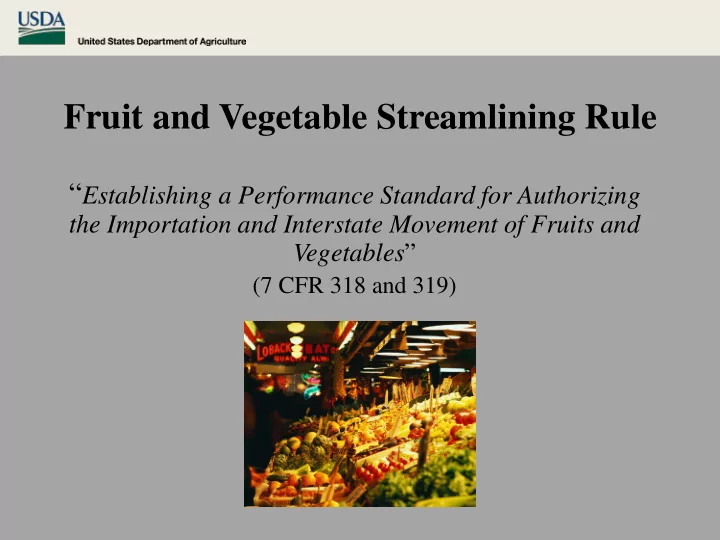

Fruit and Vegetable Streamlining Rule “ Establishing a Performance Standard for Authorizing the Importation and Interstate Movement of Fruits and Vegetables ” (7 CFR 318 and 319)
What does this rule do This rule will enable APHIS to use the noticed-based process to approve ALL new fruits and vegetables for importation from foreign countries and interstate movement from Hawaii and U.S. territories. Under this process, amendments to the Federal Regulations are not needed and approval is done via the publication of notices in the Federal Register
Why is it necessary? • Currently, import and interstate movement requirements for fruits and vegetables are codified in 7 CFR 319.56 and 318.13 • To make changes to the import and movement requirements, changes have to be done through rulemaking • Process is slow; limits our ability to respond quickly to new import requests and to make changes to requirements
Previous Streamlining Rule In 2007, APHIS published a rule that established a notice-based process for approving the importation of fruits or vegetables as long as they met one or more of the following conditions: – Inspection at the first port of entry in the United States; – Imported from a designated pest free area; – Treated under 7 CFR 305; – Phytosanitary inspection at the country of origin; or – Imported as commercial shipments only.
• In 2009, APHIS expanded the notice-based process to include interstate movement of fruits and vegetables from Hawaii and U.S. Territories.
Expanded Streamlining Rule This NEW action will add more categories of performance measures that can be used in the notice-based process. 1. Phytosanitary treatments, including pest control treatments in the field or growing site, and post-harvest treatments 2. Growing area pest mitigations including detection surveys, trapping requirements, pest exclusionary structures, and field inspections;
3. Safeguarding and movement mitigations including safeguarded transport, box labeling, limited distribution, insect-proof boxes, and commercial consignments only 4. Administrative mitigations including registered fields or orchards, registered growing sites, registered packinghouses, inspection in the country of origin by an authorized inspector (APHIS or NPPO), and monitoring through an operational workplan 5. Any other measures that the Administrator determines are appropriate.
This proposed rule will also remove the commodity specific requirements found in the CFR • 7 CFR 319.56-13 through 71 (Fruits and Vegetables) • 7 CFR 318.13-16; 318.13-18 through 22 and 318.13-24 through 26 (Hawaii and the Territories) Requirements will instead be maintained in PPQ’s Fruit and Vegetable Manual, the Fruits and Vegetables Import Requirements (FAVIR) database, and in the Hawaii and Puerto Rico Manual. In addition to the Federal Register Notices, updates to the manuals will be announced via the PPQ Stakeholder Registry.
Q 56
Subpart 318
This action will not alter our science-based process for approval • Stakeholders have 30 days to review draft pest risk assessments. • APHIS will publish an initial notice and a final notice for each action. • The public has 60 days to provide comments on the initial notice • APHIS will respond to comments in the same manner it responds to comments on a proposed rule. • Substantive comments are addressed in the final notice, published prior to issuing import permits for that commodity.
Benefits of Streamlining • Allow APHIS be more responsive to evolving pest situations • Could decrease the amount of time it takes APHIS to approve the importation or interstate movement of fruits and vegetables
Notice Process vs. Rulemaking Step Notice-based Rulemaking Description process 1 Request to authorize the import or x X APHIS receives a request to authorize move interstate a new fruit or the import or interstate movement of a vegetable new fruit or vegetable from a national plant protection organization or State/Territorial officials. 2 Pest risk assessment and x X APHIS conducts a pest risk stakeholder consultation assessment. The assessment is posted on the APHIS website for a 30-day stakeholder consultation period. 3 Risk mitigation requirements x X APHIS drafts risk mitigation documents outlining necessary measures. 4 Departmental clearance x X Officials in USDA review 5 OMB review X Officials in OMB review a description of each proposed action and determine whether to conduct a formal review of the proposed rule. OMB notification x APHIS notifies OMB of its intent to publish an initial notice, providing an opportunity for OMB oversight.
Notice Process vs. Rulemaking Cont. Step Notice-based Rulemaking Description process 6 Economic impact X APHIS conducts an economic impact analysis, per the analysis requirements of the Regulatory Flexibility Act. 7 Proposed rule x APHIS publishes a proposed rule in the Federal Register and solicits public comments for 60 days. Initial notice x APHIS publishes an initial notice in the Federal Register and solicits public comments for 60 days. 8 Departmental x x Officials in USDA review clearance 9 OMB review x Officials in OMB review a description of each final action and determine whether to conduct a formal review of the final rule. OMB notification x APHIS notifies OMB of its intent to publish a final notice, providing an opportunity for OMB oversight. 10 Final rule x APHIS publishes a final rule in the Federal Register to address public comments and authorize the commodity import. Requirements for the commodity are codified in the U.S. Code of Federal Regulations. Final notice x APHIS publishes a final notice in the Federal Register to address public comments and authorize the commodity import. Requirements for the commodity are posted in the FAVIR database, the Fruit and Vegetable Manual, or the Hawaii and Puerto Rico Manual.
Questions?
Recommend
More recommend